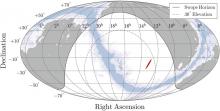
Abstract
Two neutron stars merging together generate a gravitational wave signal and have also been predicted to emit electromagnetic radiation. When the gravitational wave event GW170817 was detected, astronomers rushed to search for the source using conventional telescopes (see the Introduction by Smith). Coulter et al. describe how the One-Meter Two-Hemispheres (1M2H) collaboration was the first to locate the electromagnetic source. Drout et al. present the 1M2H measurements of its optical and infrared brightness, and Shappee et al. report their spectroscopy of the event, which is unlike previously detected astronomical transient sources. Kilpatrick et al. show how these observations can be explained by an explosion known as a kilonova, which produces large quantities of heavy elements in nuclear reactions.